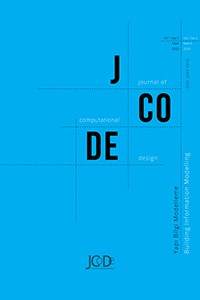THE INTEGRATION OF COMPUTATIONAL DESIGN AND BUILDING INFORMATION MODELLING THE RESEARCH OF NEW POSSIBILTIES WITH “DYNAMO”
Öz
This paper was produced from the master thesis titled “THE INTEGRATION OF COMPUTATIONAL DESIGN AND BUILDING INFORMATION MODELLING THE RESEARCH OF NEW POSSIBILTIES WITH “DYNAMO”” that published on June 2017 in ITU Architectural Design Computing Graduate Program. New opportunities will be examined with the graphic programming language added over BIM. The open sourced Dynamo selected as the practice environment. The new system formed by Revit and Dynamo started to be called Computational BIM. Dynamo is the only environment capable such exemplifications can be made. With the design model, Computational BIM containing working process will be explained. Autodesk add a plugin called “DynamoPlayer” to the Revit. With this plugin, you can run Dynamo algorithms with one click without opening the Dynamo program window. This plugin facilitates the use of the written algorithms in a large group of designers and reduce of the requirement of the knowledge and this pave the way for automations done by the end user. “DesignScript” as an advanced language created from Autodesk is integrated directly Dynamo and Python scripts can be written directly Dynamo environment.
With all the advantages, Dynamo integrated Revit environment offers a new paradigm shift as the” Computational BIM”. The algorithms are used to execute commands over geometry and BIM database, and creating logical and mathematical operations. Thanks to these logical operations, you can reduce the work force needed for the repetitive tasks and use it for the more significant works.
Since the writing of the thesis, many different add ins have been developed to the environment and the environment continues to be developed.
During the thesis, the concept of algorithm-aided design is used to describe the methods in the computer environment. The concept of “computational” has been used instead of “algorithm-aided” because of the shift in knowledge-based system in the progress of the subject. In referring to the tools described under the heading of the retrospective view, the reason for the use of the concept of “algorithm-aided” is the reference to before the shifting of “knowledge-based systems. Two different concepts have been used in this regard, paying attention to this separation.
Anahtar Kelimeler
Kaynakça
- Abrishami, S., Goulding, J. S., Pour Rahimian, F., Ganah, A., & Sawhney, A. (2014). G-BIM Framework: A Feasibility Study for the Adoption of Generative BIM Workspace for Conceptual Design Automation. Creative Construction Conference 2014, 539–543.
- Deutsch, R. (2017). Convergence: The Redesign of Design (1st ed.). Wiley.
- Garber, R. (2014). BIM Design: Realising the Creative Potential of Building Information Modelling. In BIM Design: Realising the Creative Potential of Building Information Modelling. https://doi.org/10.1002/9781118914694
- Humppi, H., & Österlund, T. (2011). Algorithm-Aided BIM. 2, 601–609.
Öz
Bu makalede, YBM üzerine eklenen grafik programlama dili ile ortaya çıkan yeni olanaklar incelenecektir. Açık kaynaklı Dynamo, çalışma ortamı olarak seçildi. Revit ve Dynamo'nun oluşturduğu yeni sistem Bilgisayımlı YBM olarak adlandırılmaya başlandı.
Makalede, bir tasarım sürecindeki Hesaplamalı YBM içeren çalışmanın aşamaları açıklanacaktır. Autodesk, Revit'e “DynamoPlayer” adlı bir eklenti de eklemiştir. Bu eklenti, yazılı algoritmaların büyük bir tasarımcı grubunda kullanımını kolaylaştırır ve bilgi gereksinimini azaltır; bu da son kullanıcı tarafından yapılan otomasyonların yolunu açar. Autodesk tarafından oluşturulan gelişmiş bir dil olarak “DesignScript” doğrudan Dynamo ile bütünleştirilir ve ayrıca Python betikleri doğrudan Dynamo ortamına yazılabilir. Tüm avantajları ile Dynamo ile entegre Revit ortamı “Hesaplamalı YBM” olarak yeni bir paradigma değişimi sunar. Algoritmalar, geometri ve YBM veritabanı üzerinde komutları yürütmek, mantıksal ve matematiksel işlemler oluşturmak için kullanılmaktadır. Bu mantıksal işlemler sayesinde, yinelenen görevler için gereken iş gücü azaltılabilir. Bilgisayar ortamındaki yöntemleri tanımlamak için genellikle algoritma destekli tasarım kavramı kullanılır. Makalede, bilgi tabanlı sistemdeki değişim nedeniyle “algoritma destekli” yerine “hesaplama” kavramı kullanılmıştır.
Anahtar Kelimeler
Teşekkür
Katkı ve yönlendirmelerinden dolayı Prof. Dr. Gülen Çağdaş' a teşekkür ederim.
Kaynakça
- Abrishami, S., Goulding, J. S., Pour Rahimian, F., Ganah, A., & Sawhney, A. (2014). G-BIM Framework: A Feasibility Study for the Adoption of Generative BIM Workspace for Conceptual Design Automation. Creative Construction Conference 2014, 539–543.
- Deutsch, R. (2017). Convergence: The Redesign of Design (1st ed.). Wiley.
- Garber, R. (2014). BIM Design: Realising the Creative Potential of Building Information Modelling. In BIM Design: Realising the Creative Potential of Building Information Modelling. https://doi.org/10.1002/9781118914694
- Humppi, H., & Österlund, T. (2011). Algorithm-Aided BIM. 2, 601–609.
Ayrıntılar
| Birincil Dil | Türkçe |
|---|---|
| Konular | Yazılım Testi, Doğrulama ve Validasyon, Mimarlık |
| Bölüm | Araştırma Makalesi |
| Yazarlar | |
| Yayımlanma Tarihi | 31 Mart 2020 |
| Yayımlandığı Sayı | Yıl 2020 Cilt: 1 Sayı: 2 |
JCoDe makaleleri "Creative Commons Attribution-NonCommercial 4.0 International License" altında yayınlanmaktadır.


